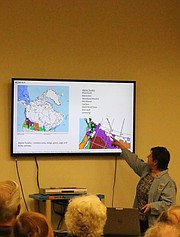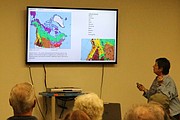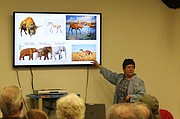A local history lesson going back 20,000 years
BONNERS FERRY — “Fourteen thousand years ago — if we were here — there would be a thousand feet of ice over our head,” U.S. Fish & Wildlife Service Zone Archaeologist Carla Burnside told the packed barn full of people during the ‘Kootenai Valley After the Glaciers’ slide presentation at the Kootenai National Wildlife Refuge.
The presentation took place on Friday evening, April 19, and was put on by the Friends of Kootenai National Wildlife Refuge. Burnside took the room of people on an adventure that spanned thousands of years, telling about the aftermath of the glacier that once covered our area and shaped the land.
“We are always looking for a variety of programs,” said Friends of Kootenai National Wildlife Refuge President Allen Rose. “Diana Ellis, who used to be the Refuge manager here, she knew Carla and thought she would make an interesting program.”
The event interested enough people that they quickly filled all the chairs. More were brought out and those were filled also, leaving standing room only for the hour and a half presentation. The youngest to attend was 10-year-old Alaina Nicoles, who came with her father, Tod Nicoles.
“I have always been really interested in this type of thing, the history of the valley,” said Tod Nicoles as to why he and his daughter attended.
“I saw the event pop up on Facebook and thought I must go to that,” said self proclaimed science geek, Nancy Croll. “I love the area we live in and I love the history of it, and the geology.”
Burnside did not disappoint the crowded room. Her enthusiasm for the subject was contagious as she zipped people through time, beginning 20,000 years ago when the Cordilleran Ice Sheet reached all the way down to Lake Pend Oreille, and then taking them through ice, torrential floods, climate and landscape changes, ending in the early 1800s.
Near the beginning of the presentation, Burnside asked the attendees if they knew how a glacier worked. Met with silence, she responded with a laugh and said, “I love this stuff so I am not going to be afraid of talking about it.”
“As glaciers advance, they push all of the soil, and rocks, and everything, ahead of them,” she explained. “If you really know what you are looking at, underneath all of those trees, there is all of the typical glacial features that you would expect to see with a glacier that carved its way through an area.”
Along with the changing landscape and climate, Burnside discussed the different animals that once existed in our area, including mammoths, camels, dire wolves, and more. The type of animal changed as the receding ice sheet changed the landscape.
“What is interesting about Lake Pend Oreille and Kootenai River — I have got to throw this in,” said Burnside, “you have here in the valley, the only landlocked white sturgeon in the world.”
When Glacial Lake Kootenay engulfed Lake Pend Oreille, it was connected to the Columbia River system, which has white sturgeon in it. About 12,000 years ago, those fish swam up into the lake and ended up here. When water went away, they became trapped in the river system.
The information packed presentation ended with a question and answer session with many people taking part.
“I think it went great,” said Burnside. “It is a great community and it is very obvious that you have a lot of people who are very interested in learning about the area that they live in, what it was, and why it is what it is now.
“When you think about the Kootenai Valley, it is just an incredible area — rich in resources, long history of people,” she said. “Because I am an archeologist, I tend to go back a little farther in time than most people think about. But when you know there were glaciers here, you have to start with those and work your way forward to really understand what it is like here.”
For the Friends of the Kootenai Wildlife Refuge, it was a success. They brought the presentation to the community completely free, even declining donations at the door.
“I love doing it,” said Burnside.
“This is what we want to do, educate people about what we have around us and give them something to do,” said Rose. “We are very pleased that many people came out.”







